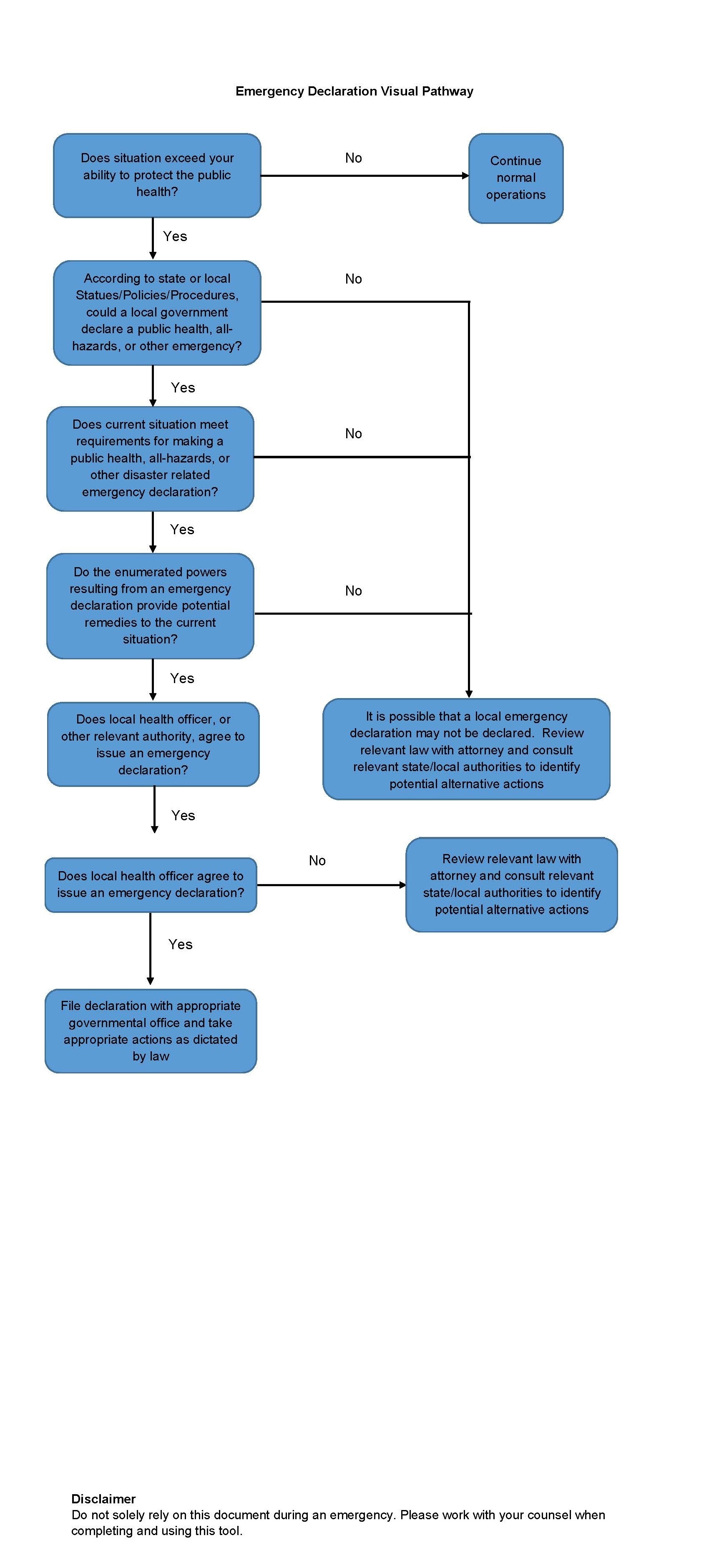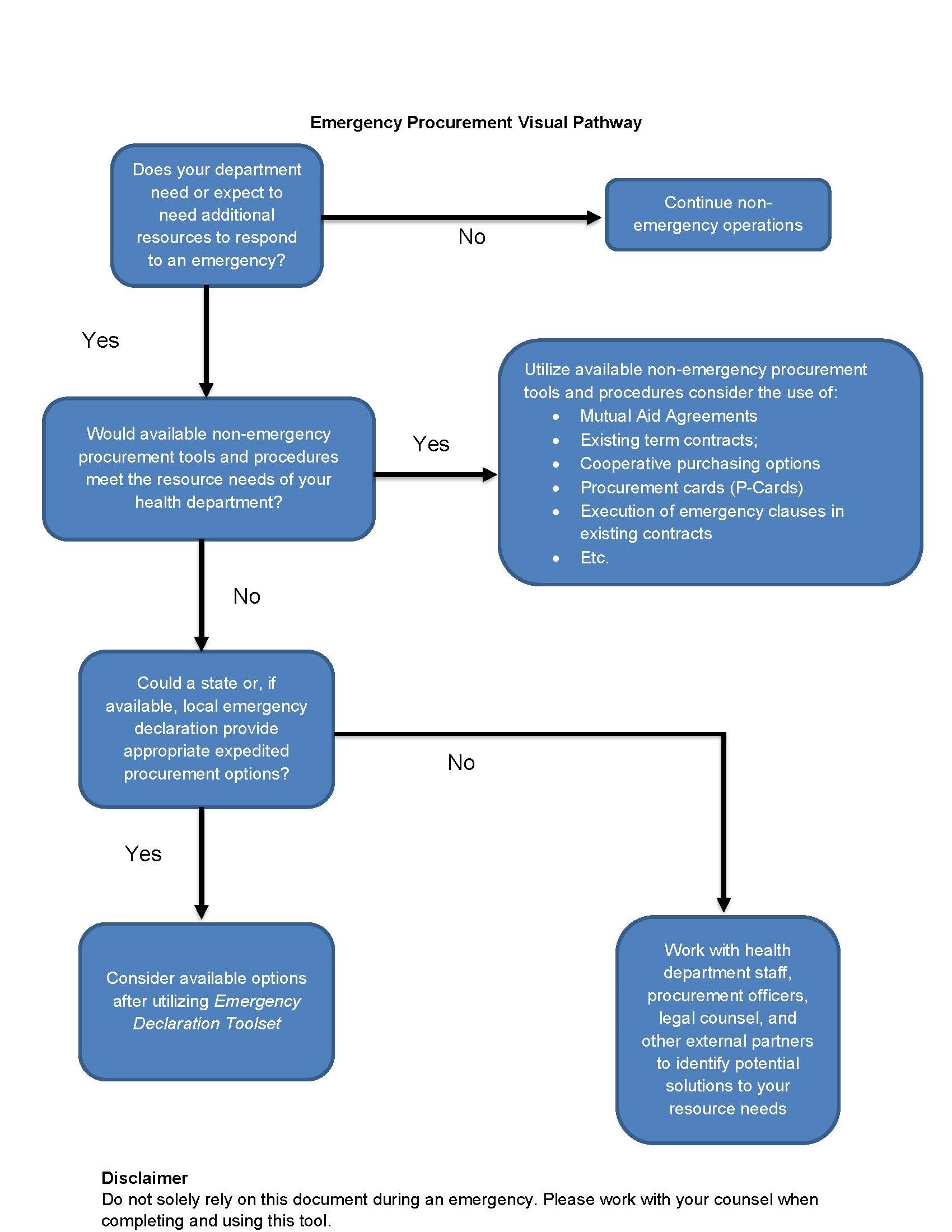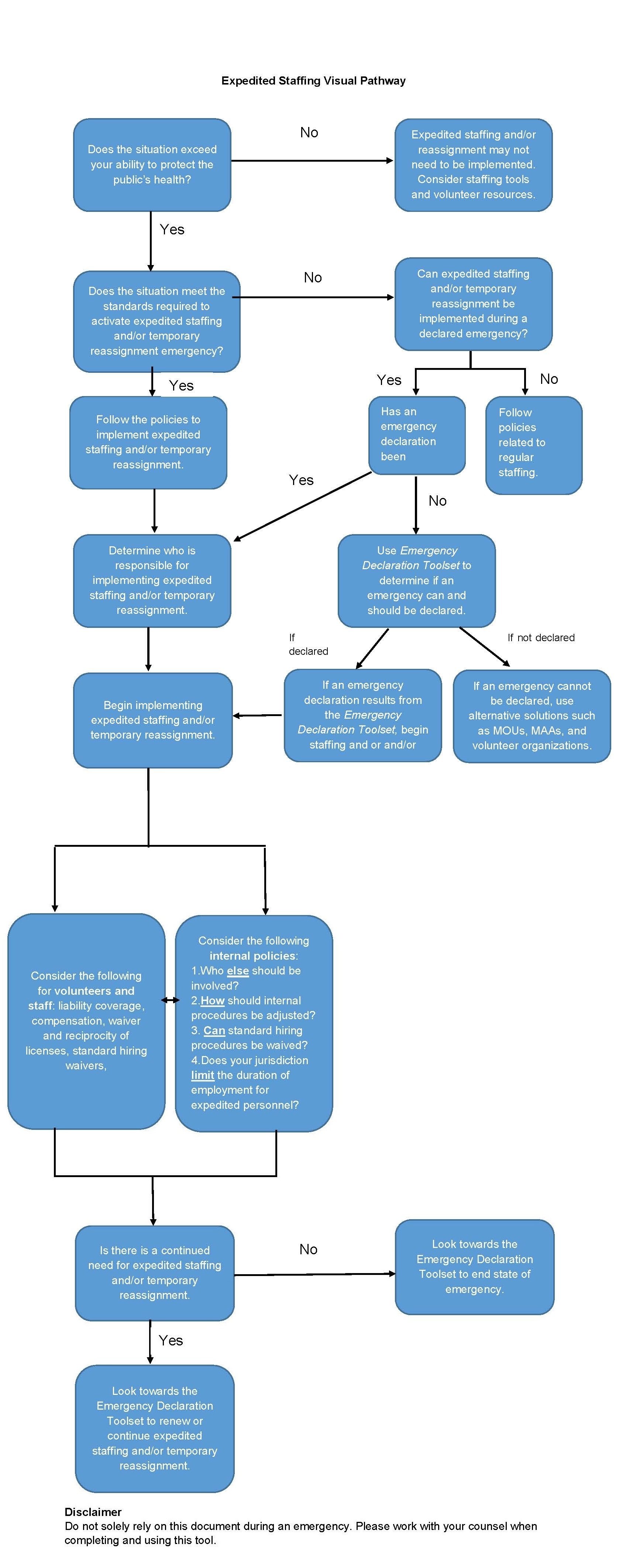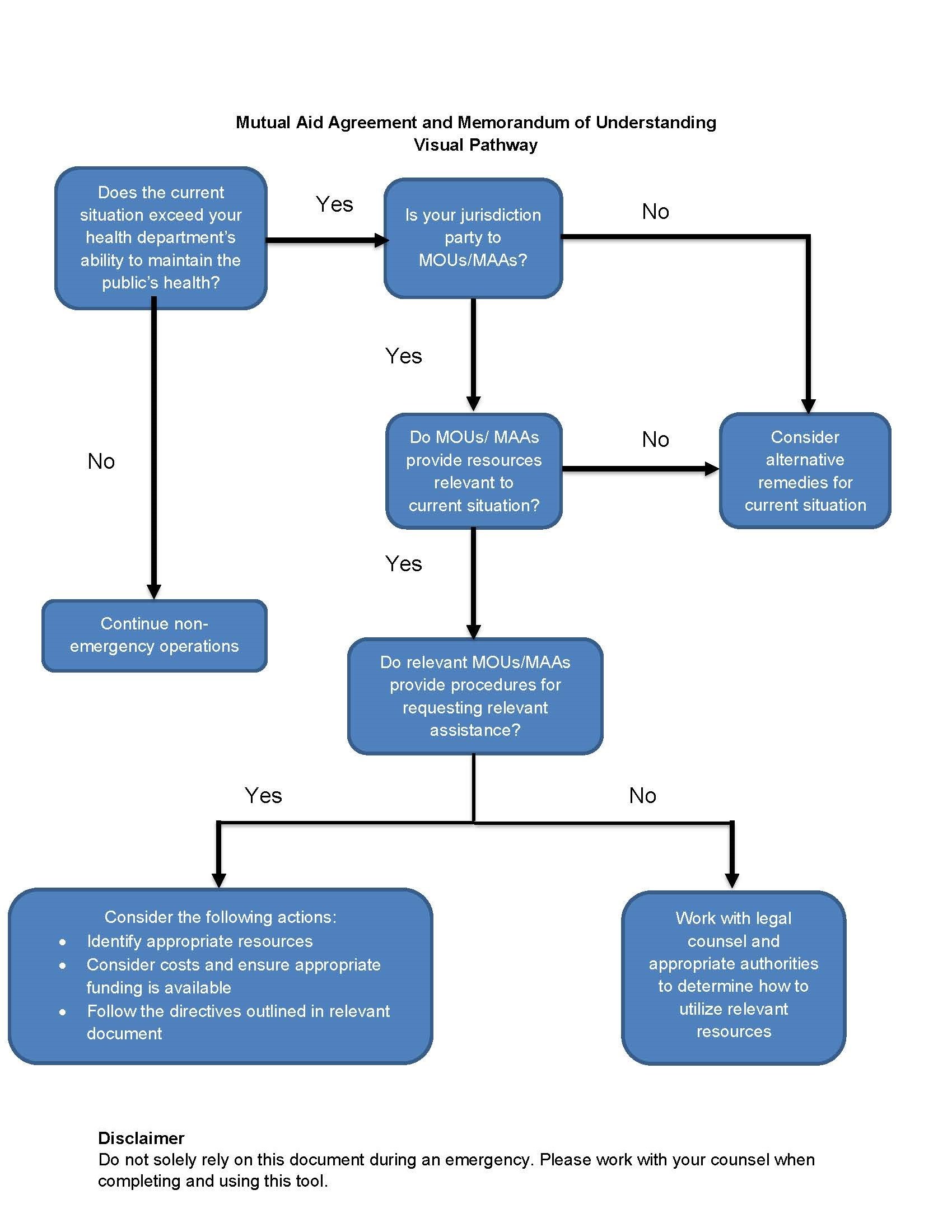Administrative Preparedness Legal Guidebook
Administrative preparedness, an often-overlooked component of public health preparedness, is the process of ensuring that fiscal, legal, and administrative authorities and practices governing funding, procurement, contracting, and hiring can be modified, accelerated, and streamlined during an emergency to support public health preparedness response and recovery efforts. Though many laws, policies, and procedures impacting administrative preparedness are available in most jurisdictions, only about half of local health department emergency preparedness coordinators are aware of their existence.[1] Additionally, nearly half do not have, or are unsure whether they have, a formal written administrative preparedness plan.[2] A lack of knowledge regarding these available options can cause undue delays in the acquisition of goods and services, hiring or assignment of personnel, disposition of emergency funds, and determination of laws needed to implement health and protective measures, potentially resulting in major consequences for communities facing public health emergencies.
The National Association of County and City Health Officials (NACCHO) developed this legal guidebook to assist public health professionals in improving their department’s administrative preparedness capabilities and ensure that its administrative operations support response activities by encouraging collaborative preparatory work among preparedness, legal, human resources, procurement, and other staff.
[1] NACCHO 2015 Preparedness Profile Assessment
[2] NACCHO 2016 Preparedness Profile Assessment
While the Administrative Preparedness Legal Guidebook is geared towards local health departments, many of its guiding principles can be scaled to assist decision-makers at the state level. This guidebook contains four sets of standalone tools (e.g., decision-aids and visual pathways) that help users incorporate their jurisdiction’s individual laws, policies, and procedures into a formal written administrative preparedness plan:
- Emergency Declaration Toolset: Supports health department decision-making processes for considering, implementing, or reviewing the use of state/local emergency declarations
- Emergency Procurement Toolset: Assists efforts to quickly procure resources during public health emergency response and recovery
- Expedited Staffing Toolset: Provides guidance for determining if/when an agency should expedite hiring, volunteer organization, or reassign personnel
- Mutual Aid Agreement and Memorandum of Understanding Toolset: Outlines steps for requesting aid from collaborating jurisdictions or entities participating in mutual aid agreements or memoranda of understanding
Each toolset may be utilized independently and follows no specific order. Please refer to the instructions below to maximize their value:
- Decision-aids
- Begin using each decision-aid with “Question #1”
- Please read the question and corresponding answers in their entirety before answering each question
- Answer each question using “yes” or “no” responses and closely follow the instructions. Some answers will instruct users to proceed to the following question while others will refer to a different document or suggest alternative courses of action
- Consult with legal counsel and other relevant staff (e.g., procurement, human resources, health department administration, etc.) to identify and insert appropriate state and local laws, policies, or procedures into the underlined locations in the decision-aid tools
- Use decision-aid in conjunction with its corresponding visual pathway from the same toolset to gain high-level perspective on progression through the described process
- Visual Pathways
- Start by reading and answering the first question featured in pathway
- Follow the path matching your response to the most recently answered question and continue to follow the pathway until you have answered all the questions
- Use visual pathway in conjunction with its corresponding decision-aid from the same toolset to gain additional insight regarding suggested courses of action, state/local law, policies, and procedures
Additional NACCHO resources and other sources are included in this guidebook to help you develop administrative preparedness capabilities.
Always consult with legal counsel for jurisdiction-specific legal advice regarding preparedness or other areas of public health.
Thank you for using the NACCHO Administrative Preparedness Legal Guidebook
Emergency declarations are considered to be the most comprehensive of all administrative preparedness authorities. These declarations can be used to modify or waive laws, policies, or procedures relating to administrative preparedness, including procurement, staffing, and reporting. These legal and regulatory requirements have been cited as potential barriers to rapid emergency response.[1] Please refer to NACCHO’s Report: Administrative Preparedness Authorities: Suggested Steps for Health Departments for further details related to emergency declarations (May be found within Administrative Preparedness Resources section of Legal Guidebook).
The Emergency Declaration Decision-aid will help support your health department’s process of determining whether there is a need to declare or request a declaration of an emergency.
Before you begin customizing the tool for use, identify and collaborate with health department staff, legal counsel, and other individuals who would provide assistance during the declaration process to fill out this decision-aid tool.
[1] Yeager, VA, Hurst, D, and Menachemi, N. State Barriers to Appropriating Public Health Emergency Response Funds During the 2009 H1N1 Response. American Journal of Public Health, Supplement 2, 2015, Vol. 105, No. S2.
Question #1: Does the current situation exceed your health department’s ability to maintain the public’s health?
- If yes, proceed to Question #2.
- If no, address the current situation within your health department’s regular capacity.
Question #2: Based on the text Insert relevant State/Local Legal Citation(s) regarding State/Local Emergency Declarations, could local governments declare a public health, all-hazards, or other disaster related emergency?
- If yes, proceed to Question #3.
- If no, a local emergency cannot be declared. Consider the use of tools and options available to your health department during non-emergency situations (organizational partnerships, Memoranda of Understanding (MOUs), Mutual Aid Agreements (MAAs), EMACs, etc.). Additionally, consult with state authority to identify an appropriate alternative course of action.
Question #3: Based on the text Insert relevant State/Local Legal Citation(s) regarding State/Local Emergency Declarations, does the current situation meet requirements for making a public health, all-hazards, or other disaster related emergency declaration?
- If yes, proceed to Question #4.
- If no, a local emergency cannot be declared. Consider the use of tools and options available to your health department during non-emergency situations. Additionally, consult with state authority to identify an appropriate course of action.
Question #4: Based on the text Insert relevant State/Local Legal Citation(s) regarding State/Local Emergency Declarations, do the powers resulting from a public health, all-hazards, or other disaster related emergency declaration provide potential remedies to the current situation?
- If yes, proceed to Question #5.
- If no, determine whether a local emergency should be declared by considering the use of tools and options available to your health department during non-emergency situations. Additionally, consult with state authority to identify an appropriate course of action.
Question #5: Refer to Relevant State/Local Legal Citation(s) regarding State/Local Emergency Declarations to determine who can declare an emergency within your local jurisdiction. Does the law provide that the local health officer can declare a public health, all-hazards, or other disaster related emergency?
- If yes, proceed to Question #6.
- If no, proceed to Question #7.
Question #6: Identify and contact a local health officer to determine an appropriate course of action. Does the local health officer agree to issue an emergency declaration?
- If yes, work with a local health officer to determine appropriate emergency declaration language, appropriate length of emergency based on what is permitted by law, and identify the process for declaring an emergency. Begin emergency operations of your local health department:
- File with county or city clerk.
- Activate the emergency response plan in your local jurisdiction.
- Take appropriate measures to protect public health as empowered by statute.
- Activate any appropriate MOUs or MAAs.
- Consult state disaster management authority if necessary.
- Proceed to Question #8.
- If no, consider the use of tools and options available to your health department during non-emergency situations. Additionally, consult with state authority to identify an appropriate course of action.
Question #7: Identify and contact the appropriate authority identified in Relevant State/Local Legal Citation(s) regarding State/Local Emergency Declarations to determine an appropriate course of action. Does the identified authority agree to issue an emergency declaration?
- If yes, work with authority and counsel to determine the appropriate emergency declaration language, appropriate length of emergency based on what is permitted by law, and identify the process for declaring an emergency. Begin emergency operations of your local health department:
1. File with county or city clerk.
2. Activate the emergency response plan in your local jurisdiction.
3. Take appropriate measures to protect public health as empowered by statute.
4. Activate any appropriate MOUs or MAAs.
5. Consult state disaster management authority if necessary.
6. Proceed to Question #8.
- If no, consider the use of tools and options available to your health department during non-emergency situations. Additionally, consult with state authority to identify an appropriate course of action.
Question #8: Has the emergency ceased to exceed your health department’s ability to effectively maintain the public’s health?
- If yes, consider ending the state of emergency through the proper authority.
- If no, continue emergency operations.

The timely procurement of goods and services is often vital for an effective response to a public health emergency.[1] Various processes may be adopted or activated to impact the speed in which these resources may be procured by public health departments, including laws allowing for the use of the open market, cooperative purchasing agreements, procurement cards (P-cards), and more.[2] The intent of this Emergency Procurement Decision-aid is to assist efforts to procure resources more quickly during emergency situations.
Prior to an event, work with colleagues to identify and contact all key individuals who might be involved with normal and emergency procurement. These individuals may be staffed within your health department, another governmental agency, or elsewhere. By contacting these individuals, you are raising awareness of their existing and potential roles during emergency situations. These connections could also assist with the creation of effective concept of operations plans (CONOPS), identify valuable resources that have been critical during previous emergency responses, consider the means for storing critical resources, and contemplate the use of pre-competing contracts for critical resources.
One should also locate existing written policies/procedures to gain an understanding of their utility to fully prepare for a potential event. Pay close attention to the common tools such as mutual aid agreements, memoranda of understanding, term contracts, cooperative purchasing agreements, emergency clauses in preexisting contracts, and procurement cards (P-Cards). Please refer to Administrative Preparedness: Emergency Procurement Strategies for Health Departments for more details (May be found within Administrative Preparedness Resources section of Legal Guidebook). Furthermore, consider your current options for accessing open markets for the procurement of supplies, materials, equipment, etc. These options could be codified in the law and may only be accessible through the declaration of an emergency.
In addition to those who work directly on procurement, be sure to also identify and work with health department staff, legal counsel, and other individuals who may be able to assist with the completion of the following decision-aid tool and provide assistance during the procurement process.
[1] Office of Public Health Preparedness and Response. Centers for Disease Control and Prevention. Atlanta, GA.
[2] Hurst D, Sharpe S, Yeager VA. Administrative Preparedness Strategies: Expediting Procurement and Contracting Cycle Times During an Emergency. Public Health Reports. 2017; Vol 132(3) 294-297.
Question #1: Does your department need or expect to need additional resources to respond to an emergency?
· If yes, see Question #2.
· If no, continue non-emergency operations.
Question #2: Consider Insert relevant State/Local citation(s) regarding State/Local expedited procurement policies and procedures. Could available non-emergency procurement tools and procedures meet the resource needs of your health department?
· If yes, utilize available non-emergency procurement tools and procedures. Consider the use of:
· If no, proceed to Question #3.
Question #3: Consider Insert relevant State/Local citation(s) regarding State/Local expedited procurement policies and procedures. Could a state or (if available) local emergency declaration provide appropriate expedited procurement options?
· If yes, utilize the Emergency Declaration Toolset and proceed to Question #4.
· If no, work with health department staff, procurement officers, legal counsel, and other external partners to identify potential solutions to your resource needs.
Question #4: Upon reviewing available emergency procurement options resulting from the declaration of an emergency Insert relevant State/Local citation(s) regarding State/Local expedited procurement policies and procedures, which option would best remedy your present situation? Consider the following options (list is not exhaustive and may not contain options relevant for your health department’s jurisdiction):
· Waiver of competitive bidding process
· Purchase pre-approval
· Emergency alteration of procurement policies/procedures

During emergency situations, local health departments and other response organizations may find that they need to adjust their staffing levels to keep up with the demands of their communities. Adjustments in staffing for emergency situations are often achieved through mechanisms that are highly structured by law or policy, including the hiring of new or temporary staff, the realignment of existing staff, or the coordination of volunteers. This Expedited Staffing Decision-aid may be used to quickly hire and/or temporarily reassign personnel during emergency situations and meet community response needs.
Prior to an event, you should first work with colleagues to identify and contact all key individuals who might be involved with normal and emergency staffing. These individuals may be staffed within your health department, within another governmental agency, or elsewhere. Contacting these individuals will raise awareness of their existing and potential roles during emergency situations. Additionally, connecting with these key individuals can help with the creation and implementation of effective staffing plans. Seek existing written policies/procedures to gain an understanding of their utility to fully prepare for a potential event. Pay close attention to common tools such as mutual aid agreements (MAAs), memorandum of understandings (MOUs), and the Medical Reserve Corps (MRC).
In addition to those who work directly on staffing, identify and work with health department staff, legal counsel, and other individuals who may be able to assist with the completion of the following decision-aid tool and provide assistance during the staffing process.
Question #1: Determine if your department or agency should expedite staffing and/or temporarily reassign personnel. Does the current situation exceed your department or agency’s ability to respond effectively to maintain the public’s health?
- If yes, proceed to Question #2.
- If no, there may be no need to expedite staffing and/or reassign personnel. Consider the use of staffing tools and volunteer resources. Additionally, consult your human resources department regarding standard hiring procedures. Other staffing options may include activating existing memorandum of understandings (MOUs) and mutual aid agreements (MAAs) with partner organizations.
Question #2: Based on the text of Insert relevant State/Local Citation(s) regarding State/Local staffing and reassignment policies and procedures, does the current situation meet the standards, laws, and/or internal policies required to activate expedited staffing and/or temporary reassignment?
- If yes, follow the policies to implement expedited staffing and/or temporary reassignment, then proceed to Question #4.
- If no, consider the law as related to emergency declarations Insert relevant State/Local l Citation(s) regarding State/Local Emergency Declarations policies and procedures. Can expedited staffing and/or temporary reassignment be implemented during a declared emergency?
- If yes, proceed to Question #3.
- If no, follow policies related to regular staffing Insert relevant State/Local Citation(s) regarding State/Local staffing and reassignment policies and procedures.
Question #3: Has an emergency declaration been declared?
- If yes, proceed to Question #4.
- If no, use the Local Health Department Emergency Declaration Algorithm to determine if an emergency can and should be declared.
- Alternative solutions to expedited staffing and/or temporary reassignment include activating MOUs and MOAs with partner and volunteer organizations such as the Medical Reserve Corps (MRC).
- Another alternative solution to expedited staffing and/or temporary reassignment is to active the Emergency System for Advance Registration of Volunteer Health Professionals (ESAR-VHP).
- If an emergency declaration results from the Emergency Declaration Toolset, proceed to Question #4.
Question #4: Who is responsible for implementing expedited staffing and/or temporary reassignment?
- Use Insert relevant State/Local Citation(s) regarding State/Local staffing and reassignment policies and procedures to determine who may be responsible for expedited staffing and/or temporary reassignment. Examples include the health director, health officer, secretary of Health and Human Services, and emergency management coordinator.
- After the designated authority has been determined, begin implementing expedited staffing and/or temporary reassignment in collaboration with the identified authority and proceed to Question #5.
Question #5: As you begin implementing expedited staffing and/or temporary reassignment, consider the following:
- How could your agency cover liability for expedited staff and volunteers? Refer to Insert relevant State/Local Legal Citation(s) to decide.
- How could your agency compensate expedited staff? Refer to Insert relevant State/Local Legal Citation(s) to decide. A surge fund or special charge code may exist.
- Does your state allow for the waiver and reciprocity of licenses and privileges during declared emergencies for expedited staff and volunteers? Refer to Insert relevant State/Local Legal Citation(s)to decide.
- Who should be involved in expedited hiring? How can the procedures be adjusted depending on the current situation? Refer to Insert relevant State/Local Legal Citation(s) to decide.
- Does your state allow for the waiver of standard hiring procedures during declared emergencies? Refer to Insert relevant State/Local Legal Citation(s) to decide.
- Does your jurisdiction limit the duration of employment for expedited personnel? Refer to Insert relevant State/Local Legal Citation(s) to decide.
Proceed to Question #6.
Question #6: Does the emergency no longer exceed your ability to respond effectively to maintain the public’s health?
- If yes, look to the Local Health Department Emergency Declaration Algorithm to renew or continue expedited staffing and/or temporary reassignment.
- If no, look to the Emergency Declaration Toolset to end the state of emergency.

The level of resources available to communities can often be strained by public health emergencies. To support these situations, local health departments may seek to work with community organizations or neighboring jurisdictions to gain access to shareable, unused resources. Mutual Aid Agreements and Memoranda of Understanding allow health departments to establish collaborations with outside organizations and partner jurisdictions to increase resources available to support public health emergency response. These documents can create binding or non-binding pacts that allow for quick resource identification and procurement.
The Local Health Department Mutual Aid Agreement and Memorandum of Understanding Decision-aid may be used to facilitate your decision-making process when considering the use of tools that allow state and local governments to seek the support of outside organizations and jurisdictions to support public health response.
Please consider reviewing this document with the assistance of your local counsel and health executive to ensure that the guidance provided is applicable to the assistance available to your jurisdiction. During this review process you may want to identify additional opportunities for leveraging memoranda of understanding and mutual aid agreements to support public health activities within your community and those of your potential partner jurisdictions.
Question #1: Does the current situation exceed your health department’s ability to maintain the public’s health?
- If yes, proceed to Question #2.
- If no, address current situation within your health department’s regular capacity.
Question #2: Review Insert relevant State/Local Citation(s) regarding State/Local mutual aid policies and procedures. Is your local jurisdiction a part of any mutual aid agreements (MAAs) or memoranda of understanding (MOUs) that are not directed by your state or the result of the Emergency Management Assistance Compact (EMAC)?
- If yes, proceed to Question #3.
- If no, consider alternative remedies for your emergency situation, including:
- Working with the state to determine how you may be able to leverage state-level MAAs or MOUs,
- Procurement options (review Emergency Procurement Toolset for guidance),
- Staffing options (review Expedited Staffing Toolset for guidance),
- Emergency declaration options (review Emergency Declaration Toolset for guidance).
Question #3: Consider the options for assistance outlined within Insert relevant State/Local Citation(s) regarding State/Local mutual aid policies and procedures. Do any of these documents provide a potential remedy for your emergency situation?
- If yes, proceed to Question #4.
- If no, consider alternative remedies for your emergency situation, including:
- Working with the state to determine how you may be able to leverage state-level MAAs or MOUs,
- Procurement options (review Emergency Procurement Toolset for guidance),
- Staffing options (review Expedited Staffing Toolset for guidance),
- Emergency declaration options (review Emergency Declaration Toolset for guidance).
Question #4: Consider document previously identified as providing a potential remedy for your emergency situation. Does this document include information regarding the procedure for requesting relevant assistance?
- If yes, consider the following actions:
- If no, work with legal counsel and appropriate authorities to determine how to utilize relevant provisions.

The following links lead to a PDF of the entire Administrative Preparedness Legal Guidebook and additional administrative preparedness resources and examples of model laws, memoranda of understanding, and mutual aid agreements:
- Administrative Preparedness Authorities: Suggested Steps for Health Departments
- Administrative Preparedness: Emergency Procurement Strategies for Health Departments
- Administrative Preparedness: Emergency Reporting Practices for Health Departments
- Administrative Preparedness and the Public Health Workforce: Suggested Strategies for Health Departments
- Guide for Incorporating Administrative Preparedness into Exercise
- NACCHO Toolbox: Administrative Preparedness Toolkit (Refine search by “Administrative Preparedness Toolkit” within drop-down menu under search bar))
- Center for Law and the Public’s Health: Model State Emergency Health Powers Act (Accessed June 2018)
- Indiana: Model Local Disaster Emergency Declaration (Accessed June 2018)
- American Bar Association: Model Procurement Code for State and Local Governments (Accessed June 2018)
If you have any questions or feedback to help improve the Administrative Preparedness Legal Guidebook, please contact NACCHO’s Preparedness team.
Public Health Law & Policy
Geoffrey Mwaungulu, Jr.
Director for Public Health Law and Policy
JavaScript is required to reveal this message. / Email
This guidebook was made possible through the support of the Centers for Disease Control and Prevention (CDC), cooperative agreement #5U38OT000172-05-00. NACCHO is grateful for this support. The views expressed within do not necessarily represent the official views of the CDC.